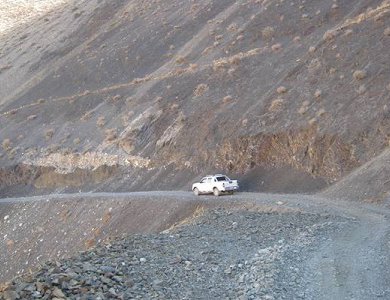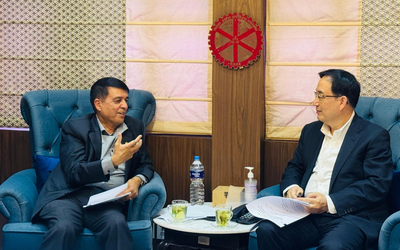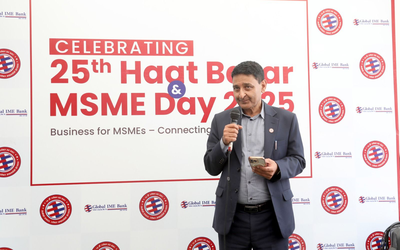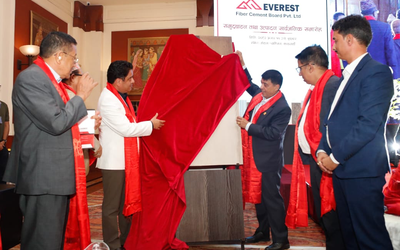
Nepal’s development experiences have shown that a balanced and sustainable interaction between communities and economic, social and environment policies is necessary to alleviate poverty and generate opportunities to the poor people living in remote and rural parts of Nepal. At a time when Nepal has been aiming to alleviate poverty by implementing various programs, the Asian Development Bank (ADB) funded projects show how the community involvement in decision making at different stages, including implementation, design and operation, brings opportunities for environmentally sustainable and inclusive economic growth to alleviate poverty in remote parts of Nepal
A community managed irrigation project has changed the livelihood of Suchita Khand of Ayodhyapuri Village Development Committee of Chitwan district, 150 kilometers South-West of capital Kathmandu. The village adjoins the Chitwan National Park. As water availability for irrigation has increased through the construction of the canal, productivity has doubled with diversification and intensification of crops. Where one-crop agriculture system prevailed earlier, multiple-crop farming has been common these days. After paddy, farmers grow vegetables as a cash crop there.
Suchita, who is a member of the user group of Riu-Tamata Ghaghar Community managed irrigation committee, is not alone to benefit from the irrigation canal. According to the project, 1,210 people of 283 households have benefited from the scheme. With a command area of 122 hectares, the irrigation project is owned and managed by a user group periodically elected by the local community. “Until a few years back, our production was not enough to feed our family for a year. Now, we even sell additional food grains and vegetables,” said Suchita.
Although in Meghauli, which remains a major entry point to Chitwan National Park by air, the people are still compelled to drink water that has a high level of arsenic and iron. However, Meghauli Town Water and Sanitation Project, now under construction, has brought a sigh of relief to the local people. Constructed with a contribution of the community and ADB under Second Small Town Drinking Water and Sanitation Project, Meghauli’s Small Towns Water Supply project will pump over 250 cum liters drinking water per day to the people living in Meghauli. It will provide drinking water to 1,765 households of five wards of the village with 11,180 permanent residents.
“Our community is ready to manage the project once it is handed over to us,” said Indra Bahadur K.C. chairman of the user group. “We know we need to pay up to Rs. 260.00 per month. However, we also receive filtered water 24 hours a day. As a lot of people annually suffer from water-borne diseases, we save medical bills once the project begins to supply pure drinking water."
As the pace of urbanization has intensified, a number of small towns have come up. "This is one of the twenty projects, currently in the construction phase in different parts of Nepal, aimed to provide water supply services to 240,000 people and sanitation service to 270,000 people," said Ram Dip Shah, project manager. "After the completion of the project, which is expected by the next year, the user group will be responsible for its maintenance and operation."
As the project lies in the buffer zone of Chitwan National Park in an area of Ghadiyal breeding, the project is of utmost importance in terms of the surrounding environment. "We are planning to put the used water in nearby ponds before discharging it to Rapti river," said Shah.
Whenever villagers have some trouble about their livestock, they knock the doors of Nirmala Khanal, 42, a mother of three children. Trained under the Decentralized Rural Infrastructure and Livelihood Project –Additional Financing (DRILP-AF), Khanal, a resident of Soti Pasal of Lamjung District, 200 kilometers west of capital, has been providing services for the people as her employment.
Along with providing training for self employment, the section of the road upgraded under the DRILP-AF in Sundar Bazar and Soti Pasal of Lamjung has brought drastic changes. The road has reduced the time for driving as well as increased the land prices along the road sides. Suvadra Danai, 32, a high school teacher of Sundar Bazar, says the road is a real boon. “Till a few years ago, one would have to sell the land at throw-away prices. However, the price has gone up now,” said Danai.
"Out of 23.2 kilometer Sundarbazar-Kunchha and Duipiple Road, an eight-kilometer road section is still under construction and it is likely to be completed next year,” said Jay Ram Shrestha, engineer of District Development Committee, Lamjung. Since 2008, the project has already provided technical training in the areas of beekeeping, beauty parlor, driving, veterinary, electric warring and so on.
Chitwan and Lamjung have better access to link Nepal and more opportunities available due to its link to the capital city. People living in Mustang, a remote mountain district of Nepal, have to face much more hardships due to lack of roads, market and finance.
Two other projects are designed for remote mountain districts like Mustang. Supported by the Asian Development Bank, Rural Reconstruction and Rehabilitation Sector Development Project (RRRSDP) High Mountain Agribusiness and Livelihood (HIMALI) Project has been helping rural population to enhance their livelihood through different schemes.
As the rural road, drinking water and irrigation projects aimed at poverty reduction in the lower hills and plain region, High Mountain Agribusiness and Livelihood Improvement (HIMALI) and RRRSDP have been supporting the private sector to participate in employment generation and poverty reduction through improving the connectivity to capital. HIMALI project aims to increase the number of mountain agribusiness, providing agribusiness grant to local entrepreneurs, groups and community. One of the aims of the project is to improve income in selected high mountain areas.
The project is assisting farmers and enterprises to strengthening the linkages taking advantage of the gradual improvement in infrastructure to realize the existing demands for mountain projects.
Along with completing the construction of Kagbeni-Jhaite road linking upper Mustang with Jomsom and the rest of Nepal, RRRSDP also completed 6 schemes for water supply and sanitation benefiting 4,403 population of 675 households. With a total cost of 362,869,950.54 rupees, the project also constructed 4 trail bridges, 2 small irrigations and 2 community buildings, 1 primary school building, and a bio-engineering, Nursery in Kagbeni and Samar. The project also provides training in driving, hotel management, sewing, and cooking and apple management to 72 individuals.
“Before the construction of road, people living in the area used to pay over Rs. 200 per kilo rice, the situation has changed now. Similarly, our apple and potato did not see the market. Now, we are getting good price for our products," said Tashi Ambe of Samar village. “We are selling apple, potato and barley as far as up to Pokhara."
After the construction of the road, farmers living in Tangbe-Chaile-Samar section of the road have already started to plant apple in the community land.
"This is a unique project directed to improve the living standards of poor people living in the Himalayas. We take utmost care to protect the fragile ecology and social security of people living in upper Mustang," said Ram Krishna Sapkota, deputy director general of DoLIDAR.
RRRSDP focused its attention to poverty reduction and inclusive development by enhancing the effectiveness and efficiency of the delivery of public services, and improving access of rural residents to economic opportunities and social service.
As per the project outputs, the project improved roads, developed and improved community based supplementary rural infrastructure, enhanced equity, employment and income opportunities for the poor and disadvantaged, strengthened institutional capacity of the government institutions at various levels and communities and improved the project management.
“This is the road constructed with support from the local community taking consideration of social and environmental safeguards,” said Ram Krishna Sapkota, project coordinator of RRSDP.
Implemented through Department of Local Infrastructure Development and Agricultural Roads (DOLIDAR), Rural Reconstruction and Rehabilitation Sector Development Program (RRSDP) are funded by Asian Development Bank.
"This road is likely to end our hardships," said Tashi Khambo, 45. The road has made a tremendous contribution in the livelihood of the people living in remote parts of the Himalayas where the ratio of poverty is rampant.
There are also growing concerns about environmental and social safeguards."ADB’s environmental and social safeguards are a cornerstone of support to inclusive economic and environmentally sustainable growth. We commit to the full implementation of the safeguard policy, and work with our borrowers and other stakeholders to put the policy principles and requirements into practice,” said Deepak Bahadur Singh, senior environment officer at ADB resident mission. “We ensure the environmental soundness and sustainability of projects and support the integration of environmental consideration into the project into the decision making process.”
When such projects are implemented, the question of land acquisition and social safeguards always arises. "We take care of agenda like social inclusion as well as social safety of the poor and deprived population in the course of implementation of the projects," said Laxmi Prasad Subedi, senior social development officer, ADB.
Himali Project has shown how public-private partnership can successfully work in remote Nepal. Under the project, five sub-projects have already been approved with a total amount of over 21 million rupees and approved over 15 million rupees in grants for those projects. The projects include Rainbow Trout farm in Jhasa Lete, Shyangfola Community Agriculture Farm, Marpha, Mustang Dairy Industry, Marpha, Himali Sherpa Apple Nursery Marpha and Muktinath Multiple Cooperatives Limited Jharkot Muktinath.
Situated at over 6,000 feet, Ghansa Rainbow Trout Farm of Lete VDC of Mustang district is the first of its kind to utilize fresh water of Kali Gandaki watershed to produce Trout Fish. With an aim to produce 7,400 kilo of trout fish from the fresh water, four entrepreneurs have already invested over 7.9 million rupees. After the production of trout, it will end to import need for fish from plains of Nepal.
“Although there is risk, we agreed to invest in the project,” said Navin Bhattachan, chairman of the group. It will generate employment opportunities as well. As there is a big market, we can even sell it up to Pokhara.”
Maya Gurung, 28, chairperson of Muktinath Multiple Cooperative, has also noticed a lot of change in her village. After the completion of road to link the village, they have started commercial production of Tora Juice. Seabuck Thorn Squash is produced from Hippophae-Tibetana, natural and wild berries found above 3500 meters. From collecting raw materials to producing the juice, it is an industry handled by women of Jharkot.
“Himali project encouraged mountain entrepreneurs to show their potential by investing their own seed money with the grants,” said Dr. Amar Bahadur Shaha, project director. The people will sustain it for their own benefit. “As poor people in mountains do not have enough money, nobody will come to invest here.”
Situated at Jharkot 4 of Muktinath Village Development Committee, Muktinath Tora Juice Industry has produced the juice and sent it to sell in Kathmandu. Promoted by Women Development Committee and Muktinath Multiple Cooperatives Ltd, the juice helped to improve the livelihood of women in general and households of the Jharokt and nearby village in particular. Himali project under public private partnership has set an example to generate the private resources in the development of the region. It also encourages people to take risks in investing local industry.
The level of community involvement in the development programs and projects determines the level of achievement and prosperity of the people living in the targeted areas. At a time when various development programs are undergoing throughout the country, Asian Development Bank has shown that the initiatives of various development projects will make a difference in the life of people.
Community managed projects and flow of remittances have helped reduce poverty in Nepal dramatically in recent years, from 41 per cent 31 percent in 2011.
Nepal has exceeded the Millennium Development Goals for poverty reduction, cut poverty by more than half and become one of the best global performers in poverty reduction. Despite such achievements, the gap between rich and poor continues to increase. The gap is growing in urban and rural areas.
Nearly 40 per cent of children under the age of five suffer from malnutrition and 28 per cent in the same age group were underweight in 2010. This is Nepal’s key challenge, and also its key opportunity: to improve the lives of those children and their families and lift them out of poverty.
How can Nepal reduce poverty further? By investing in its people, its human capital, for improved health, education, skills and jobs and better access to finance along with investments in critical infrastructure – and that’s where Nepal’s development partners, including the Asian Development Bank can help.
Nepal and the Asian Development Bank have been partners in development since 1969 and Asian Development Bank has already provided nearly $ 3.1 billion in concessional loans and grants for investment projects and about $175 million technical assistance grants. The ADB has provided analyses, advice and financing to Nepal – to both the public and the private sector – in areas ranging from education and healthcare to infrastructure, energy policy, clean drinking water and access to finance for rural micro-borrowers and small and medium-sized businesses.
The Asian development Bank has begun working with Nepal on the next phase of our partnership by preparing five- year Country Partnership Strategy for Nepal Interim Strategy Note. “I am very happy to see the completion of the projects and contribution made in the remote parts of Nepal," said an ADB top official.
“The strategy has a long five year term horizon, and is well aligned with the government’s development objective of accelerated, sustainable, inclusive economic growth,” said Kenichi Yokoyama, ADB’s country director to Nepal, who visited the project sites in Mustang.
ADB’s grants and credits over the last couple of years have built critically needed drinking water systems for urban populations, including in Kathmandu and other projects are improving agriculture and providing vital roads, bridges and transportation links.
Through projects like HIMALI, ADB is also focusing on private sector development. It has invested in infrastructure to support development. ADB support has also helped create jobs and raise incomes for people by promoting trade opportunities, and facilitating businesses’ access to outside markets.
“We support programs that meet the needs of the people. These initiatives and additional resources are part of our expanded and increased efforts to assist Nepal in bringing people out of poverty," told ADB's country director Kenichi Yokoyama to New Spotlight.
ADB is Nepal’s partner in finding a path forward for the Nepali people – especially those children, families and communities held back by unemployment, low incomes, health concerns and lack of income prospects. Education, improved health care, better skills and training can improve incomes for families and working people.
As ADB has approved the Country Partnership Strategy 2013-2017 for Nepal focusing on Nepal's overall development, committing to build historic partnership with the people of Nepal to help them build a better future, poor people living in remote parts of Nepal like in Mustang, Lamjung and Chitwan now have reasons to rejoice

Keshab Poudel
Poudel is the editor of New Spotlight Magazine.
- FOURTH PROFESSOR Y.N. KHANAL LECTURE: Nepal-China Relations
- Jun 23, 2025
- Colonel JP CROSS: Centenary Birthday
- Jun 23, 2025
- REEEP-GREEN: Empowering Communities with MEP
- Jun 16, 2025
- BEEN: Retrofitted For Green
- May 28, 2025
- GGGI has been promoting green growth in Nepal for a decade: Dr. Malle Fofana
- May 21, 2025















